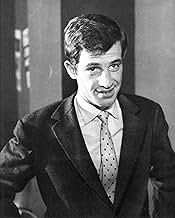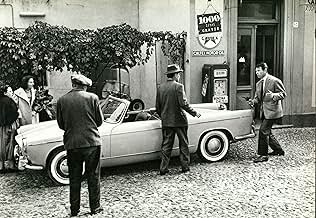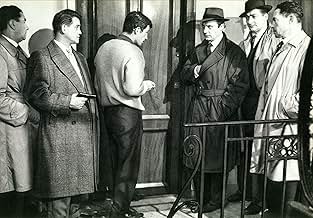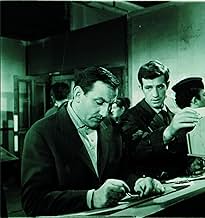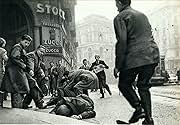Classe tous risques
- 1960
- Tous publics
- 1h 50min
NOTE IMDb
7,5/10
4,8 k
MA NOTE
Abel Davos est un criminel, traqué en Italie. La police se rapproche, alors lui et son copain Raymond s'arrangent pour s'enfuir en France avec la femme d'Abel, Thérèse, et leurs deux jeunes ... Tout lireAbel Davos est un criminel, traqué en Italie. La police se rapproche, alors lui et son copain Raymond s'arrangent pour s'enfuir en France avec la femme d'Abel, Thérèse, et leurs deux jeunes fils.Abel Davos est un criminel, traqué en Italie. La police se rapproche, alors lui et son copain Raymond s'arrangent pour s'enfuir en France avec la femme d'Abel, Thérèse, et leurs deux jeunes fils.
- Réalisation
- Scénario
- Casting principal
Simone Desmaison
- Thérèse Davos
- (as Simone France)
Jean-Pierre Zola
- Le patron de l'agence privée
- (as J.P. Zola)
Philippe March
- Jean Martin
- (as Aimé de March)
Avis à la une
In Milan, the gangster Abel Davos (Lino Ventura) is sentenced to death "In absentia" and decides to return to France. Abel is a family man with wife Thérèse Davos (Simone France) and two sons, and his partner Raymond Naldi (Stan Krol) helps Abel and his family to flee to Nice. However Thérèse and Raymond are killed by the police and Abel uses his former friends in Paris to help him to go to Paris with his sons. They hire the driver Eric Stark (Jean-Paul Belmondo) to bring Abel and his kids to Paris in an ambulance. Along their journey, Eric helps the aspirant actress Liliane (Sandra Milo) on the road and she also goes to Paris in the ambulance. But soon Abel learns that he is alone and his friends when he was powerful will not help him and he counts only with the support of Eric. What will happen to him?
"Classe tous risques" is a great film-noir with the story of the last days of a gangster. The plot shows that there is no code of honor or friendship after the fall of a powerful gangster. All his former friends do not help him when he needs. The conclusion is adequate for the whole situation. My vote is eight.
Title (Brazil):"Como Fera Encurralada" ("Like Trapped Beast")
"Classe tous risques" is a great film-noir with the story of the last days of a gangster. The plot shows that there is no code of honor or friendship after the fall of a powerful gangster. All his former friends do not help him when he needs. The conclusion is adequate for the whole situation. My vote is eight.
Title (Brazil):"Como Fera Encurralada" ("Like Trapped Beast")
Classe Tous Risques (The Big Risk) is repeatedly recommended every time I look up a Jean-Pierre Melville film that I had to give it a watch as soon as possible. Since I've been discovering Melville and seemingly working backwards through his filmography, it would be easy for me to mistake this as one of his films, but it was made in 1960, by Claude Sautet, before Melville would come and stake his claim on french neo-noir.
Classe Tous Risques has two of the best lead men of the time, Lino Ventura and Jean-Paul Belmondo. Ventura plays Abel, a gangster exiled in Italy with his wife and two kids, who wants to come back to Paris because the police are closing in on him. After a roaring and fast paced opening with a big surprise, Abel eventually gets hooked up with Eric Stark (Belmondo) who wants to get into the criminal underworld. Stark becomes Abel's chauffeur and eventual only friend in an underworld that turns it's back on Abel after everything he's done and been through. The film shows the the duality of the two men, the older Abel at the end of his time after tragedy strikes him, and the younger Eric starting off the same way Abel did, falling in love with a beautiful woman who sticks with her man despite the world they are a part of. It never ends pretty for them, or their loved ones. Its one thing to see a individual criminal come to his demise, its different when he has loved ones he risks taking down with him.
Much like Melville's film, the seemingly simple story gets more subtlety complicated as it goes along. As usual, as what I feel with Melville's films, it left my head spinning (in a good way) and dying to re watch it again to pick up what I missed the first time. Classe Tous Risques is a definite keeper.
Classe Tous Risques has two of the best lead men of the time, Lino Ventura and Jean-Paul Belmondo. Ventura plays Abel, a gangster exiled in Italy with his wife and two kids, who wants to come back to Paris because the police are closing in on him. After a roaring and fast paced opening with a big surprise, Abel eventually gets hooked up with Eric Stark (Belmondo) who wants to get into the criminal underworld. Stark becomes Abel's chauffeur and eventual only friend in an underworld that turns it's back on Abel after everything he's done and been through. The film shows the the duality of the two men, the older Abel at the end of his time after tragedy strikes him, and the younger Eric starting off the same way Abel did, falling in love with a beautiful woman who sticks with her man despite the world they are a part of. It never ends pretty for them, or their loved ones. Its one thing to see a individual criminal come to his demise, its different when he has loved ones he risks taking down with him.
Much like Melville's film, the seemingly simple story gets more subtlety complicated as it goes along. As usual, as what I feel with Melville's films, it left my head spinning (in a good way) and dying to re watch it again to pick up what I missed the first time. Classe Tous Risques is a definite keeper.
10urigafni
Odd one should be able to stumble into "Classe Tous Risques" only by chance; it should be on any "best of film-noir" list, including IMDb's.
Lino Ventura is as good as ever; knowing of his dire, delicate family situation gives extra weight to his almost expressionless face and brief dialogues. Belmondo's restrained performance under Sautet's firm direction only shows what a wonderful actor he could - and should -have been.
"Classe Tous Risques" is utterly mininal, dry and cold, without Melville's artistic scenery, pretty faces and fancy cars. It is almost film-noir meet neo-realism. Davos' few, hard words to his children describing their life of secrecy from there on get a hold on your throat to the end of the film.
The final sentence of the film - a voice-over telling of Davos' end in no more than ten dry, sombre words - leaves you with a hard punch in the stomach.
A true jewel in the great crown of French film-noir.
Lino Ventura is as good as ever; knowing of his dire, delicate family situation gives extra weight to his almost expressionless face and brief dialogues. Belmondo's restrained performance under Sautet's firm direction only shows what a wonderful actor he could - and should -have been.
"Classe Tous Risques" is utterly mininal, dry and cold, without Melville's artistic scenery, pretty faces and fancy cars. It is almost film-noir meet neo-realism. Davos' few, hard words to his children describing their life of secrecy from there on get a hold on your throat to the end of the film.
The final sentence of the film - a voice-over telling of Davos' end in no more than ten dry, sombre words - leaves you with a hard punch in the stomach.
A true jewel in the great crown of French film-noir.
10colaya
A film reduced to its essentials (photographed images in sequence) to portray the dawn and dusk of two stoical gangsters that are also human beings. Milan, Nice, Paris, a journey from exile to tragedy, the disloyalty of old partners, a total stranger that becomes the younger image in the mirror, a new friendship---in Sautet hands, all of these human happenings are conveyed not by words but by the power of images, expressions, action, angles, movement, gestures, moments. Sautet belongs to the same league of Melville, Bresson and other masters of the craft of putting together "pictures in motion".
"Less is more". Minimalism assumes that the moviegoer is a human being too, s/he interprets, reflects, makes sense and finds meanings. No distractions and full advantage of the cinematic form: images, sound, edition. Not everything has to be shown or explained. Less words and less information demand for the viewer to fill in the blanks, an active role that might be hard to take. But once the watcher accepts the challenge, the outcome is a tailor-made experience---he is not a passive watcher anymore.
"Less is more". Minimalism assumes that the moviegoer is a human being too, s/he interprets, reflects, makes sense and finds meanings. No distractions and full advantage of the cinematic form: images, sound, edition. Not everything has to be shown or explained. Less words and less information demand for the viewer to fill in the blanks, an active role that might be hard to take. But once the watcher accepts the challenge, the outcome is a tailor-made experience---he is not a passive watcher anymore.
I have just watched on Italian TV the excellent crime drama CLASSE TOUS RISQUES (1960; aka: THE BIG RISK), directed by Claude Sautet and starring the late Lino Ventura (in one of his best roles) and a very young Jean-Paul Belmondo.
This film came out at the tail end of a string of French gangster thrillers of the 50s, the most famous of which was, of course, Jules Dassin's seminal DU RIFIFI CHEZ LES HOMMES (1954; aka: RIFIFI). I haven't watched RIFIFI in a long time but I plan to acquire the Criterion DVD some time or other. In fact, I have only postponed it, really, because of the reported audio-synch problem present on the disc's first pressings and, being a non-U.S. resident, Criterion's policy dictates that no defective discs delivered outside Region 1 territories can be replaced! Still, in light of THE BIG RISK, I may risk it [sic] all the same!
When the film came out it converged with a spate of Nouvelle Vague releases including Jean-Luc Godard's A' BOUT DE SOUFFLE (1960; aka: BREATHLESS) starring, of course, Jean-Paul Belmondo himself. It is easy to assume that his characterization in THE BIG RISK is nowhere near as iconic as his Laszlo Kovacs in Godard's film, but after all his is a supporting role (albeit pulled off with confidence and charm) and he is all too obviously overshadowed by the underrated Ventura, who dominates the film from beginning to end. Ventura was a regular in gangster films of the period: he was in Jacques Becker's masterful TOUCHEZ PAS AU GRISBI (1953; aka: HANDS OFF THE LOOT!) playing the main villainous role and in which he conducts an effective vis-à-vis with nominal star Jean Gabin, but he then took the lead for Jean-Pierre Melville's magnificent thriller set in WWII, L'ARMEE' DES OMBRES (1969; aka: ARMY OF SHADOWS).
Incidentally, next week Criterion will release Melville's BOB LE FLAMBEUR (1955) and I hope they can put their hands on other films by this French master, notably LES ENFANTS TERRIBLES (1950), from the play by Jean Cocteau; LE DEUXIEME SOUFFLE (1966; aka: SECOND BREATH), also starring Lino Ventura; LE SAMOURAI (1967), his undisputed chef d'oeuvre; the aforementioned L'ARMEE' DES OMBRES and LE CERCLE ROUGE (1970; aka: THE RED CIRCLE). It is worth noting that the last two may very well be future Criterion DVDs. For the record, I have recorded ENFANTS, SAMOURAI, ARMEE' and CERCLE (which I have yet to watch) off French TV, along with the atypical LEON MORIN, PRETRE (1961) and the little-seen LE DOULOS (1962; aka: THE FINGER MAN), both of which star Jean-Paul Belmondo.
To go back to THE BIG RISK, it was dismissed at the time as old-fashioned in light of the Nouvelle Vague, though the few stylistic touches it has are effective exactly because they are sparse and unexpected. After an explosive start, the film relaxes its grip for the first half in order to establish plot (somewhat unusual in its emphasis on the domestic problems of gangsters) and characterization (particularly in eliciting audience sympathy for the lone anti-hero). The plot does have its improbable turns: for example, Belmondo's and Sandra Milo's characters are a bit too good to be true, aiding Ventura without batting an eyelid (despite the obvious danger involved) just minutes after making his acquaintance, while the ending is a bit of a letdown (the film is abruptly interrupted and the plot resolved with a hurried voice-over explanation)...but Ventura's solid performance as a man betrayed, quietly desperate at first but driven eventually to sudden eruptions of violence, holds the film firmly together and makes THE BIG RISK a classic of its kind.
Other films by Claude Sautet I have watched are LES CHOSES DE LA VIE (1969), MAX ET LES FERRAILLEURS (1971; aka: MAX AND THE SCRAP-MONGERS), CESAR ET ROSALIE (1972), all on Italian TV, and VINCENT, FRANCOIS, PAUL ET LES AUTRES (1974), which I have recorded off French TV. All of these are low-key yet very interesting and thought-provoking films, aided a great deal by a superb selection of actors (Michel Piccoli in CHOSES, MAX and VINCENT; Romy Schneider in the first three titles; and Yves Montand in the last two). VINCENT, FRANCOIS, PAUL ET LES AUTRES is perhaps Sautet's best film: it co-stars Serge Reggiani, Gerard Depardieu (one of his first), Marie Dubois and Stephane Audran (an extended cameo, really, but effective nonetheless).
As I have said, I wish that some of the films I mentioned by Claude Sautet and Jean-Pierre Melville, including of course THE BIG RISK, will one day be released on DVD. Supplements for such films may be hard to come by, I guess, but a quality print in the Original Aspect Ratio with a transfer to match are the least we could expect for them. I know that some of the above-mentioned films are already available on French Region 2 DVD but unfortunately most of them do not carry English subtitles. Although I do have quite a basic knowledge of the French language, I am still not fluent enough to get by without any subtitles. However, I would very much like to read your opinions of French Region 2 DVDs and will affect a search through the Mobius archives for that purpose, though I may still have to post my queries about particular French DVDs which I am interested in purchasing in a new thread in this Forum in the near future.
This film came out at the tail end of a string of French gangster thrillers of the 50s, the most famous of which was, of course, Jules Dassin's seminal DU RIFIFI CHEZ LES HOMMES (1954; aka: RIFIFI). I haven't watched RIFIFI in a long time but I plan to acquire the Criterion DVD some time or other. In fact, I have only postponed it, really, because of the reported audio-synch problem present on the disc's first pressings and, being a non-U.S. resident, Criterion's policy dictates that no defective discs delivered outside Region 1 territories can be replaced! Still, in light of THE BIG RISK, I may risk it [sic] all the same!
When the film came out it converged with a spate of Nouvelle Vague releases including Jean-Luc Godard's A' BOUT DE SOUFFLE (1960; aka: BREATHLESS) starring, of course, Jean-Paul Belmondo himself. It is easy to assume that his characterization in THE BIG RISK is nowhere near as iconic as his Laszlo Kovacs in Godard's film, but after all his is a supporting role (albeit pulled off with confidence and charm) and he is all too obviously overshadowed by the underrated Ventura, who dominates the film from beginning to end. Ventura was a regular in gangster films of the period: he was in Jacques Becker's masterful TOUCHEZ PAS AU GRISBI (1953; aka: HANDS OFF THE LOOT!) playing the main villainous role and in which he conducts an effective vis-à-vis with nominal star Jean Gabin, but he then took the lead for Jean-Pierre Melville's magnificent thriller set in WWII, L'ARMEE' DES OMBRES (1969; aka: ARMY OF SHADOWS).
Incidentally, next week Criterion will release Melville's BOB LE FLAMBEUR (1955) and I hope they can put their hands on other films by this French master, notably LES ENFANTS TERRIBLES (1950), from the play by Jean Cocteau; LE DEUXIEME SOUFFLE (1966; aka: SECOND BREATH), also starring Lino Ventura; LE SAMOURAI (1967), his undisputed chef d'oeuvre; the aforementioned L'ARMEE' DES OMBRES and LE CERCLE ROUGE (1970; aka: THE RED CIRCLE). It is worth noting that the last two may very well be future Criterion DVDs. For the record, I have recorded ENFANTS, SAMOURAI, ARMEE' and CERCLE (which I have yet to watch) off French TV, along with the atypical LEON MORIN, PRETRE (1961) and the little-seen LE DOULOS (1962; aka: THE FINGER MAN), both of which star Jean-Paul Belmondo.
To go back to THE BIG RISK, it was dismissed at the time as old-fashioned in light of the Nouvelle Vague, though the few stylistic touches it has are effective exactly because they are sparse and unexpected. After an explosive start, the film relaxes its grip for the first half in order to establish plot (somewhat unusual in its emphasis on the domestic problems of gangsters) and characterization (particularly in eliciting audience sympathy for the lone anti-hero). The plot does have its improbable turns: for example, Belmondo's and Sandra Milo's characters are a bit too good to be true, aiding Ventura without batting an eyelid (despite the obvious danger involved) just minutes after making his acquaintance, while the ending is a bit of a letdown (the film is abruptly interrupted and the plot resolved with a hurried voice-over explanation)...but Ventura's solid performance as a man betrayed, quietly desperate at first but driven eventually to sudden eruptions of violence, holds the film firmly together and makes THE BIG RISK a classic of its kind.
Other films by Claude Sautet I have watched are LES CHOSES DE LA VIE (1969), MAX ET LES FERRAILLEURS (1971; aka: MAX AND THE SCRAP-MONGERS), CESAR ET ROSALIE (1972), all on Italian TV, and VINCENT, FRANCOIS, PAUL ET LES AUTRES (1974), which I have recorded off French TV. All of these are low-key yet very interesting and thought-provoking films, aided a great deal by a superb selection of actors (Michel Piccoli in CHOSES, MAX and VINCENT; Romy Schneider in the first three titles; and Yves Montand in the last two). VINCENT, FRANCOIS, PAUL ET LES AUTRES is perhaps Sautet's best film: it co-stars Serge Reggiani, Gerard Depardieu (one of his first), Marie Dubois and Stephane Audran (an extended cameo, really, but effective nonetheless).
As I have said, I wish that some of the films I mentioned by Claude Sautet and Jean-Pierre Melville, including of course THE BIG RISK, will one day be released on DVD. Supplements for such films may be hard to come by, I guess, but a quality print in the Original Aspect Ratio with a transfer to match are the least we could expect for them. I know that some of the above-mentioned films are already available on French Region 2 DVD but unfortunately most of them do not carry English subtitles. Although I do have quite a basic knowledge of the French language, I am still not fluent enough to get by without any subtitles. However, I would very much like to read your opinions of French Region 2 DVDs and will affect a search through the Mobius archives for that purpose, though I may still have to post my queries about particular French DVDs which I am interested in purchasing in a new thread in this Forum in the near future.
Le saviez-vous
- AnecdotesCo-writer/Director Claude Sautet said after the shooting that he did not know that the Abel Davos - Danos - character was inspired by a gangster who collaborated with the Nazis against French resistance and Jews during German occupation.
- Citations
Eric Stark: The best thing about me is my left hook.
- ConnexionsFeatured in Claude Sautet ou La magie invisible (2003)
Meilleurs choix
Connectez-vous pour évaluer et suivre la liste de favoris afin de recevoir des recommandations personnalisées
- How long is The Big Risk?Alimenté par Alexa
Détails
Box-office
- Montant brut aux États-Unis et au Canada
- 132 928 $US
- Week-end de sortie aux États-Unis et au Canada
- 11 945 $US
- 20 nov. 2005
- Montant brut mondial
- 132 928 $US
- Durée1 heure 50 minutes
- Couleur
- Rapport de forme
- 1.66 : 1
Contribuer à cette page
Suggérer une modification ou ajouter du contenu manquant

Lacune principale
What is the Mexican Spanish language plot outline for Classe tous risques (1960)?
Répondre




